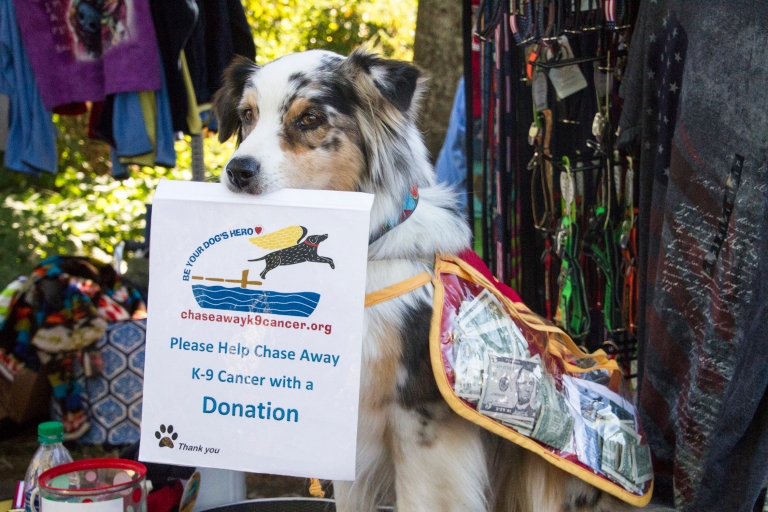One might think that at a Moonshine Festival all would be cheery and light-hearted, and for the most part it was. But as I wandered around, I spied what I first thought was a stuffed animal sitting on top of a large wooden wine/whiskey barrel. But there was something about it that made me look closer – and when I did, I realized it wasn’t a stuffed animal at all…but a real, live dog that was sitting perfectly still atop the barrel holding a sign in its mouth:

As you can see from the sign, they were seeking donations to fight canine cancer. That is a subject that hits close to my heart as we lost three of our boxers to cancer, including our most recent one, Casper.
Cancer is a terrible, terrible disease – whether it is in humans or in animals. I don’t mean to minimize the horrible impact cancer has on people and families. It is an awful thing when anyone or anything gets cancer. Sometimes the things people do, like smoking cigarettes or chewing tobacco, are known to be carcinogenic…but people do it anyway. But I don’t know of a dog or cat or any other animal that willinging and knowingly did anything to cause their cancer. I know that most people don’t, either. I hate cancer.
Did I make a donation? Of course! And I think you would have, too.
ON THIS DAY IN HISTORY: in 1415, during the Hundred Years’ War between England and France, Henry V, the young king of England, led his forces to victory at the Battle of Agincourt in northern France.
Two months before, Henry had crossed the English Channel with 11,000 men and laid siege to Harfleur in Normandy. After five weeks the town surrendered, but Henry lost half his men to disease and battle casualties. He decided to march his army northeast to Calais, where he would meet the English fleet and return to England. At Agincourt, however, a vast French army of 20,000 men stood in his path, greatly outnumbering the exhausted English archers, knights, and men-at-arms.
The battlefield lay on 1,000 yards of open ground between two woods, which prevented large-scale maneuvers and thus worked to Henry’s advantage. At 11 a.m. on October 25, the battle commenced. The English stood their ground as French knights, weighed down by their heavy armor, began a slow advance across the muddy battlefield. The French were met by a furious bombardment of artillery from the English archers, who wielded innovative longbows with a range of 250 yards. French cavalrymen tried and failed to overwhelm the English positions, but the archers were protected by a line of pointed stakes. As more and more French knights made their way onto the crowded battlefield, their mobility decreased further, and some lacked even the room to raise their arms and strike a blow. At this point, Henry ordered his lightly equipped archers to rush forward with swords and axes, and the unencumbered Englishmen massacred the French.
Almost 6,000 Frenchmen lost their lives during the Battle of Agincourt, while English deaths amounted to just over 400. With odds greater than three to one, Henry had won one of the great victories of military history. After further conquests in France, Henry V was recognized in 1420 as heir to the French throne and the regent of France. He was at the height of his powers but died just two years later of camp fever near Paris.
TRIVIA FOR TODAY: A massive 8.8 earthquake in Chile moved the city of Concepción 10 feet to the west on February 27, 2010. This quake also shortened Earth’s day and slightly changed the rotation of the planet.
Galen, I am right with you on this!!!! Holly
LikeLike